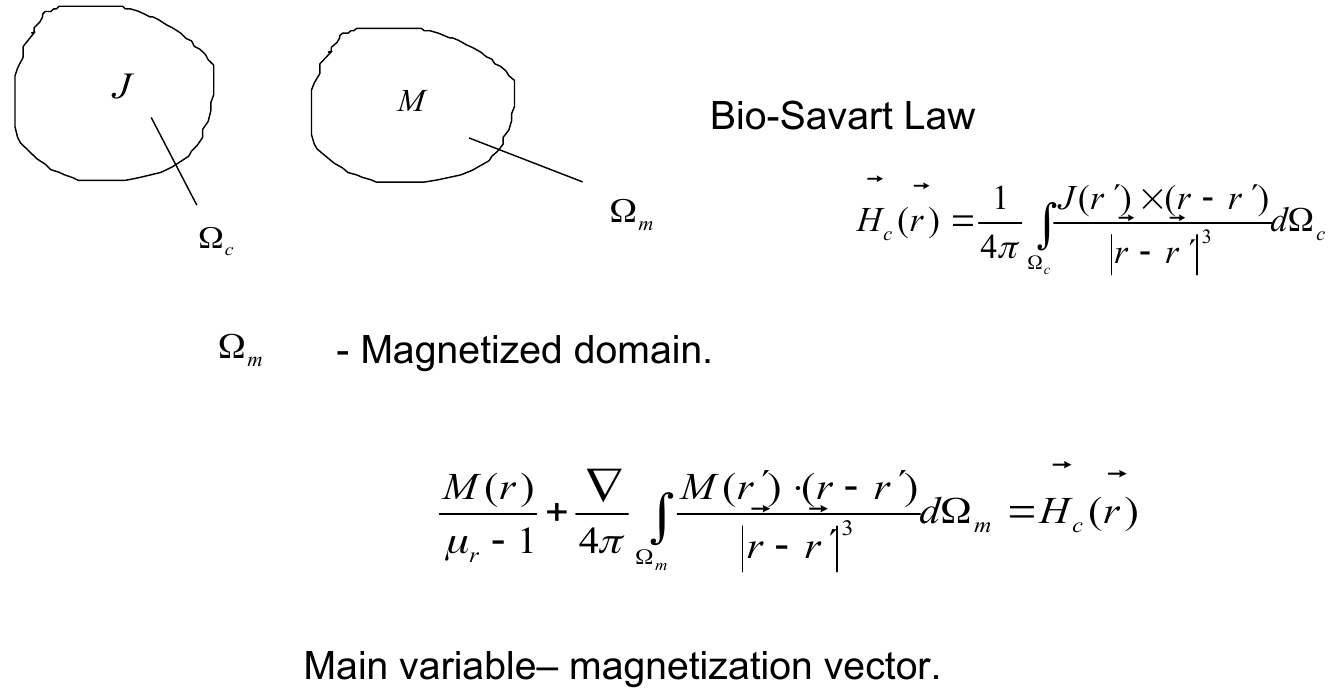
- •1. Electrostatic field. Coulomb’s law. Gauss law (Электростатическое поле. Закон Кулона. Закон Гаусса)
- •Variables and units
- •Coulomb’s Law. (ЗаконКулона)
- •Electric Field Strength e and Displacement Field d. (Напряжённостьисмещениеэлектрическогополя)
- •Gauss’ Law. (ЗаконГаусса)
- •2. Poisson’s and Laplace’s equations for the potential of electric field (Уравнения Пуассона и Лапласа для потенциала электрического поля) Electric Potential. (Электрический потенциал)
- •Poisson’s and Laplace’ s equations. (Уравнения Пуассона и Лапласа)
- •3. Electrostatic Energy (Электростатическая энергия) Electrostatic Energy (Электростатическаяэнергия)
- •Virtual experiment. (Эксперимент по нахождению энергии системы)
- •Consequences (Следствия)
- •4. Power and Joule’s Law (Энергия и закон Джоуля-Ленца)
- •5. Continuity Equation (Уравнения непрерывности) ContinuityEquation (Уравнение непрерывности)
- •Image method for the flat boundary between magnetic media (Метод изображений для плоской границы между магнитными носителями)
- •8. Static magnetic field. Biot–Savart’s Law. Ampere’s Law (Статическое магнитное поле. Закон Био–Савара. Закон Ампера)
- •Variables and units (Переменные и единицы измерения)
- •Main Relations (Основные соотношения)
- •Magnetic flux density (Индукция магнитного поля)
- •Biot-Savart’s law (Закон Био-Савара)
- •Ampere’s law (Закон полного тока)
- •The cut in the space (Разрез в пространстве)
- •Laplace equation for the scalar magnetic potential (Уравнение Лапласа для скалярного магнитного потенциала)
- •10. Vector magnetic potential. Inductance (Векторный магнитный потенциал. Индуктивность)
- •Vector magnetic potential (Векторный магнитный потенциал)
- •Magnetic flux (Магнитный поток)
- •Differential equation for the vector magnetic potential (Дифференциальное уравнение для векторного магнитного потенциала)
- •Gauging of the vector magnetic potential (Калибровка векторного магнитного потенциала)
- •Integral presentation of the vector magnetic potential (Интегральное представление векторного потенциала)
- •Inductance (Индуктивность)
- •Mutual inductance (Взаимная индуктивность)
- •Inductance of thin contours (Индуктивность тонких контуров)
- •12. Internal inductance of a thin conductor (Внутренняя индуктивность тонкого проводника) Flux linkage of a thin current layer (Потокосцепление тонкого слоя с током)
- •Internal inductance of a thin conductor (Внутренняя индуктивность тонкого проводника)
- •13. Inductance of a two wire transmission line (Индуктивность двухпроводной линии).
- •14. Variable separation method in a cylindrical coordinate system (Метод разделения переменных в цилиндрической системе координат). Application of Laplace’s equation (Применение уравнения Лапласа).
- •Angular function (Угловая функция)
- •Radial function (Радиальная функция)
- •General solution of the Laplace’s equation in a cylindrical coordinate system (Общее решение уравнения Лапласа в цилиндрической системе координат)
- •15. The Faraday’s law (Закон электромагнитной индукции).
- •Lenz’s Law (правило Ленца)
- •Induction by a temporal change of b (Индукция за счёт временного изменения b)
- •16. Induction through the motion of a conductor (Индукция за счет движения проводника).
- •17. Induction by simultaneous temporal change of b and motion of the conductor (Индукция одновременным изменением b во времени и движением проводника).
- •18. Unipolar generator (Униполярный генератор).
- •19. Hering’s paradox (Парадокс Геринга)
- •20. Diffusion of magnetic fields into conductors (Распространение электромагнитного поля в проводнике)
- •21. Periodic electromagnetic fields in conductors. (Периодическое электромагнитное поле в проводниках)
- •Penetration of the electromagnetic field into a conductor. (Проникновение электромагнитного поля в проводник)
- •The skin effect. (Скин-эффект)
- •22. Poynting theorem. (Теорема Пойнтинга) Electromagnetic Field Energy. (Энергия электромагнитного поля)
- •The rate of decrease of the electromagnetic field energy in a closed volume. (Скорость уменьшения энергии электромагнитного поля в замкнутом объёме)
- •Transmission of energy in a dc line (Передача энергии в линиях постоянного тока)
- •The field picture near the wires with current (Картина поля вблизи провода с током)
- •25. Energy flows in static electric and magnetic fields (Поток энергии в статических электрических и магнитных полях).
- •26. The reduced magnetic potential (Редуцированный магнитный потенциал). Reduced scalar magnetic potential (Редуцированный скалярный магнитный потенциал)
- •Combination of scalar magnetic potential and reduced magnetic potential (Комбинация скалярного магнитного потенциала и редуцированного магнитного потенциала)
- •27. Classification of numerical methods of the electromagnetic field modeling (Классификация численных методов моделирования электромагнитного поля).
- •Classification of the problems (Классификация проблем)
- •Classification of the methods (Классификация методов)
- •28. Method of moments
- •Discretization of the problem domain (Дискретизация проблемной области)
- •29. Basic principles of the finite element method.
- •30. Finite functions (Ограниченная функция – отлична от нуля только в пределах треугольника)
- •Simplex coordinates
- •Approximation of functions inside triangles (Аппроксимация функций внутри треугольника)
- •Approximation of the equation (Аппроксимация уравнения)
- •31. Weighted residual method (метод взвешенных невязок)
- •32. Weak formulation of the electromagnetic field modeling problem
- •33. Boundary conditions in electric and magnetic fields
- •1) First type boundary conditions
- •34. Main equations of electromagnetic field in integral form.
- •35. Main equations of electromagnetic field in differential form.
- •36. Electric field of a point charge (Электрическое поле точечного заряда)
- •37. Electric field of a uniformly charged sphere (Электрическое поле равномерно заряженной сферы)
- •38. Flat capacitor. Field. Surface charge. Capacity. (Плоский конденсатор. Поле. Поверхностный заряд. Вместимость.)
- •39.2 Inductance of a cylindrical coil with the rectangular cross section(Индуктивность цилиндрической катушки прямоугольного сечения).
- •4 0.1 Electric field induced by charged line placed above conducting surface (Электрическое поле, создаваемое заряженной линией, помещенной над проводящей поверхностью).
- •4 0.2. Magnetic field induced by the line with a current placed above a ferromagnetic surface with infinitely high magnetic permeability
27. Classification of numerical methods of the electromagnetic field modeling (Классификация численных методов моделирования электромагнитного поля).
There are two different items, that are used for this classification. First of them, evidently the use the method depends strongly on the problem, which it solves. That is why first classification is classification of the problems.
Classification of the problems (Классификация проблем)
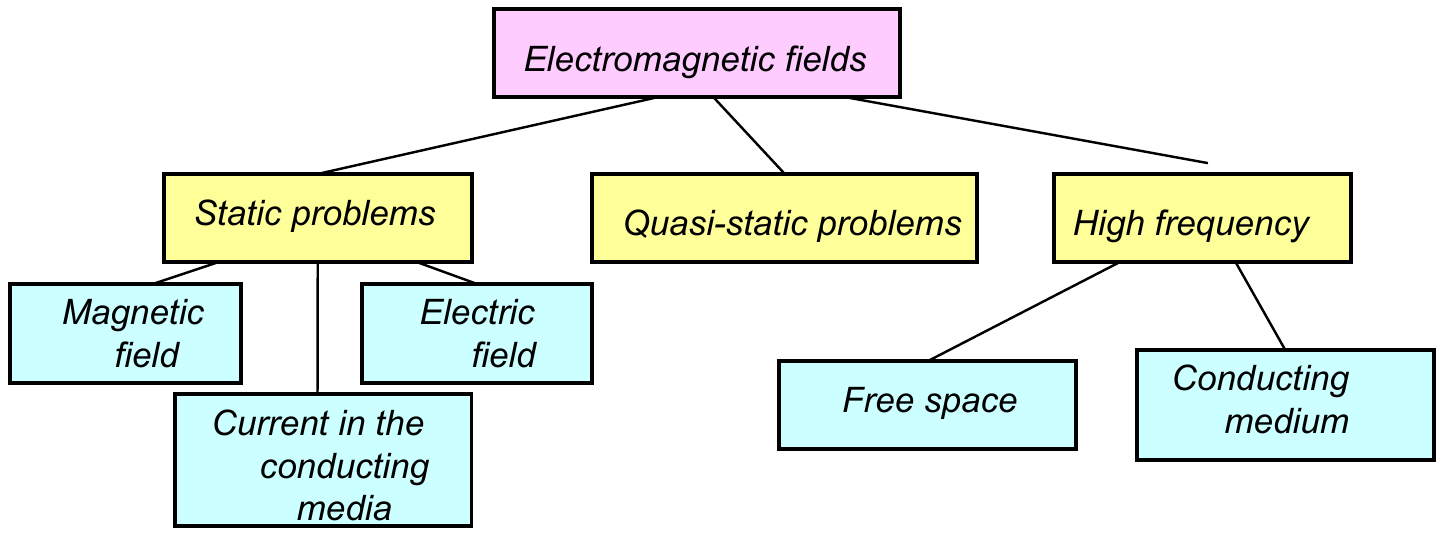
Static problems – do not depend on time (DC current in the conducting media). This problem is differing from the electrostatics. We already define what is it electrostatics. First property of this field is absenting of the time dependent fields and there are no currents. So, really these three different types of the problem.
Quasi-static problems – usually here assumed the electromagnetic field which changing time according to sinusoidal dependence. But it isn’t exactly so. This type of electromagnetic problems covers also transient processes (переходные процессы). But the main property of this type of problems is that we neglect one part of the currents – displacement current. Usually this corresponds to low frequency or the transient processes with small rate of the electric or magnetic field components time dependence. In such a case, we first consider interaction between the electric field and magnetic field inside conductors.
High frequency – usually these high frequencies are considered in free space. That corresponds for radio waves, for example. But also, sometimes high frequencies fields are considered in the conducting medium. Typically, this is not the case which is considered by high frequency problems because the current in the conductors assumes, that there are no displacement currents because displacement currents by default are not introduced in conductors, but in the case of bad insulator (material is in insulator, but there is a very small conductivity. So, the conductivity currents may influence on the final balance between electric and magnetic field.). In such not very often mad (?) cases a nevertheless high frequency equations are implemented to calculate the electromagnetic field inside these bad conductors.
So that is the general overview of the problems which may be solved both analytical methods, if the geometry of the system is simple enough or in general cases by numerical methods.
Classification of the methods (Классификация методов)
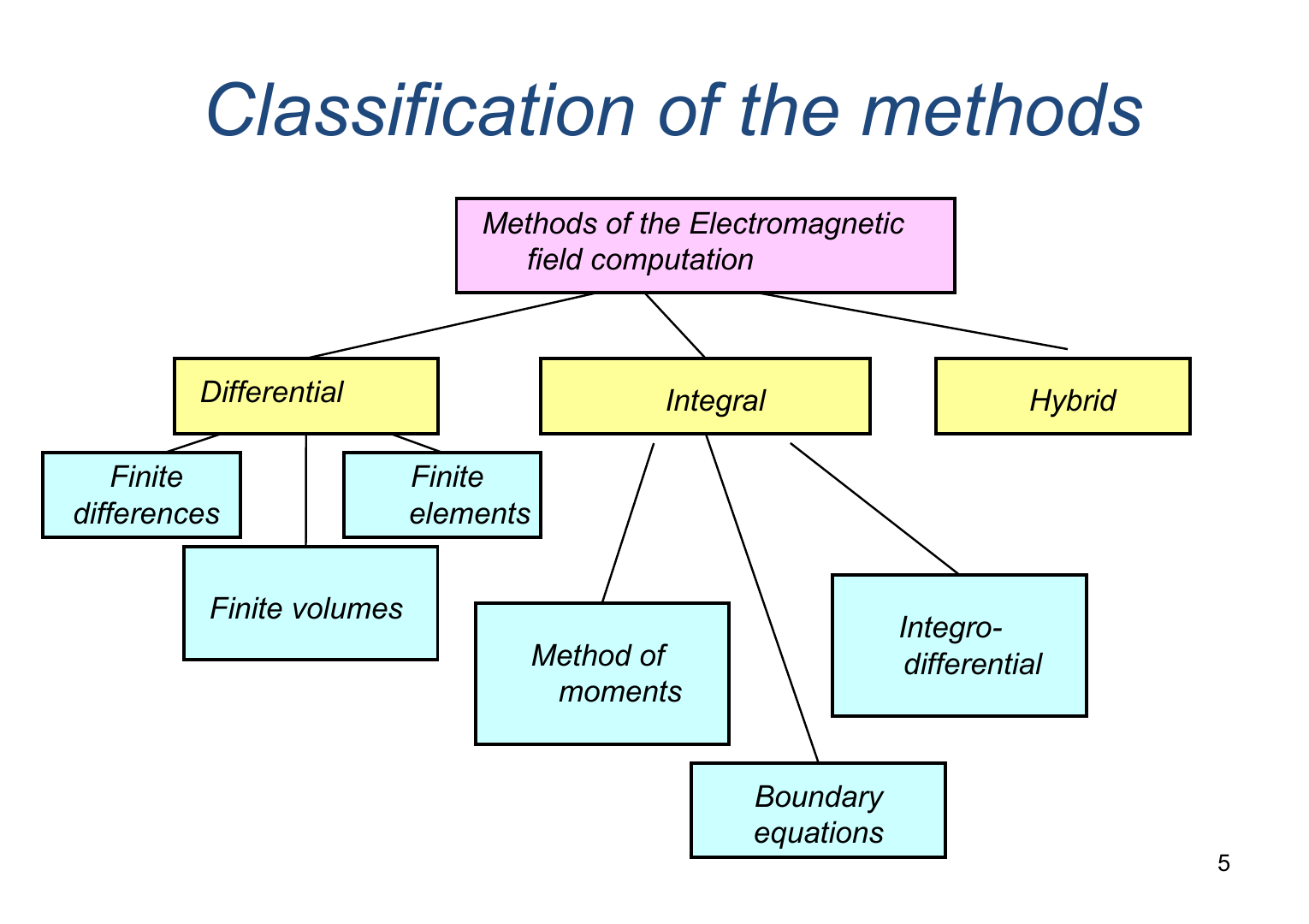
Finite difference – метод сеток (метод конечных разностей)
Finite elements – метод конечных элементов (используется в Quickfield)
Finite volumes – метод конечных объемов
Method of moments (method of spatial equations) – метод моментов
Boundary equations – метод граничных уравнений
Integro-differential – интегрально-дифференциальный метод
Hybrid method combines several methods (Boundary equations+ Finite elements)
28. Method of moments
This method is quite simple but is not very accurate. It is usually applied to solving magnetic problems. The basis of this method is a system of a several basic equations.
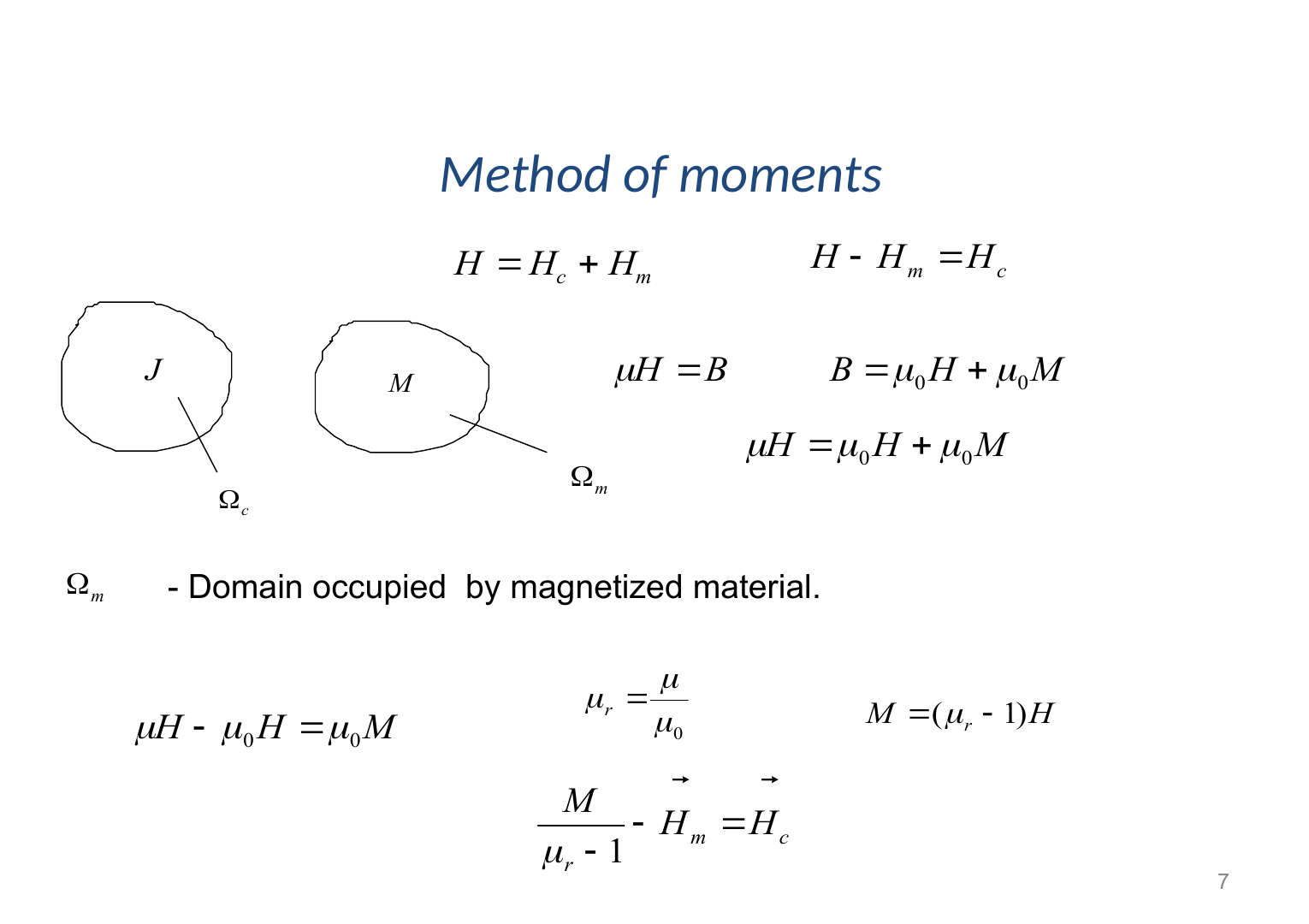
Hm – magnetic field induced by the magnetized object
Hc – magnetic field induced by the current (may be calculated independently on solving the general problem by Biot-Savart Law or another)
МЮr -relative magnetic permeability
M – magnetization
МЮо – magnetic permeability in vacuum
Here and then we will assume, that we work inside isotropic medium.
The general system may consist of volume which if field with magnetize material (область M). may be ferromagnetic (H=102–103) or a material with smaller magnetic permeability. Another part of the volume is the field with the primary sources (область J) (usually currents, but also it may be permanent magnet)
These two volumes are surrounded by air or vacuum. In principle the domain may be infinitely big (tend to infinity). Method of moments hasn’t boundaries, so in this case it is more accurate, than other methods.
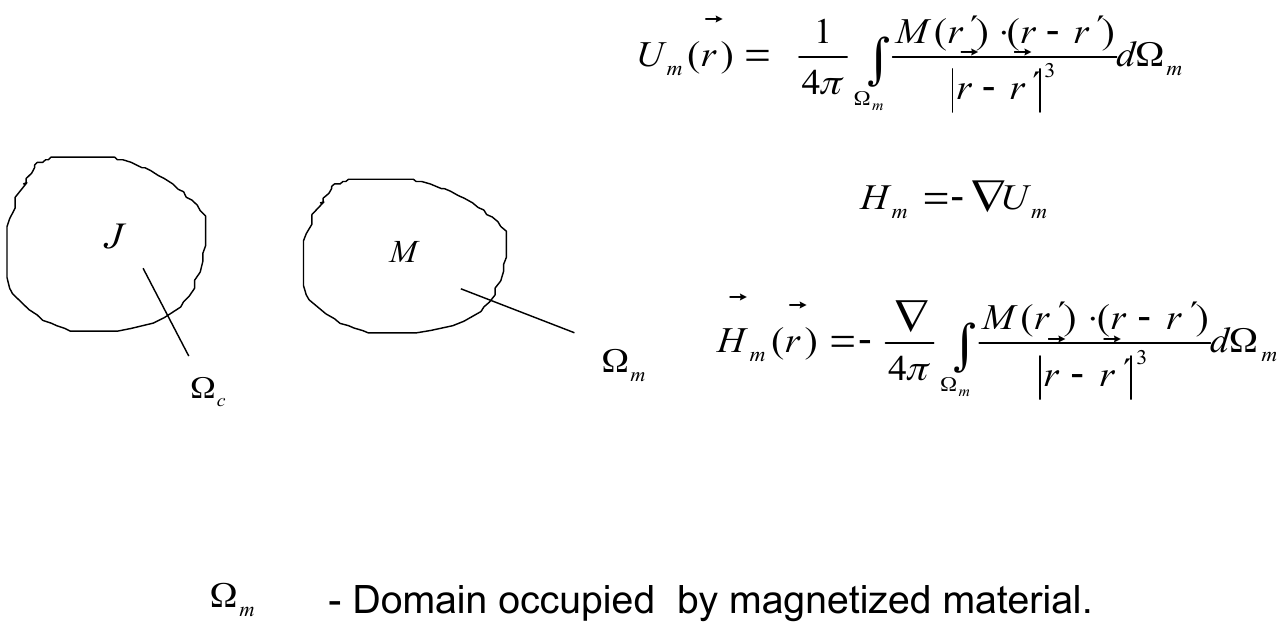
Um – reduced magnetic potential
The first relation is some kind of the Coulomb Law for the magnetic field. So, we use magnetization instead of charges.
We have changed a variable. Now is not field intensity the unknown value, but magnetization.
